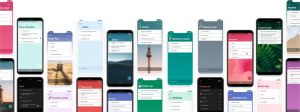Smarter scribbles
An update that seems genuinely useful is the handwriting recognition and indexing that Samsung added. It uses the neural processing unit (NPU) on the device’s Snapdragon 855 chipset to translate and convert your scribbles on the fly. Once you’ve written down your thoughts, for example, you can export them to Microsoft Word via the Samsung Notes app. It takes almost no time at all for the conversion to happen and you can quickly share the document with a colleague. The system will also recognize things like dashes or bullets and format accordingly.
Not only that, you don’t have to actively hit convert for your scrawls to be searchable later on. The Notes app recognizes what you’ve written regardless and indexes everything so you can find the to-do list you made just by searching for a specific task.
After I wrote down a shortlist using the Samsung Notes app on a demo Note 10+, I tapped on my words on the page and a box popped up. It showed what the phone thought I had written and was surprisingly accurate. It made a few mistakes, showing “spen” instead of “S Pen” and “note mining” instead of “note writing.” But I should stress that my handwriting is horrific and I’m impressed the algorithm recognized as much of it as it did.
Video capture and production
Note owners are power users. They also tend to take quite a bit of video and might appreciate new features like live focus in video recording. This adds bokeh and other special effects around your subject’s face while you’re capturing footage. It seemed to work well in a demo. The phone quickly and accurately recognized the subject’s face and applied background blur to the footage in real-time with no lag.
Samsung also added a feature called Zoom In Mic, which uses the Note 10’s multiple microphones to target the audio coming from a specific point in your frame. Say you’re at a park and zoom in on a band playing in the distance. The phone will focus on the instruments and bump up the volume from them while minimizing the noise of passersby behind or around you. It sounds interesting, but we’ll have to wait for a more thorough test to really tell if it works.
Another tool we didn’t get to try out was the improved native video editor, which lets you combine clips into a single timeline, trim them andc add transitions, background music and animations. You can use the Note 10’s S Pen to scrub through your timeline more precisely. You can even export your work straight to social media, so you can create the perfect Instagram video without having to download a whole other app.
One new feature I did check out, AR Doodle, isn’t particularly useful, but it is fun. Basically, this is an expansion of Live Message on the Note 8, which let you draw on pictures and send them as animations to your friends. AR Doodle lets you take a photo or video, then pin drawings to a person or object in the scene. The Note 10 will spatially map the room and save where you dropped your drawings, so when you return to the same room, your doodles will reappear, as if they’ve just been sitting there where you left them. It’ll also recognize the faces of people you’ve marked up, so the same doodles will show up on them again when they re-enter the scene. It was fun watching a tiara and necklace follow my head as I bobbed around for a video, but I doubt I’ll use this often in the real world.
Bridging the desktop gap
Samsung also wants to make it easier for you to use DeX, its Android-based desktop multitasking setup. Previously, you needed to connect an external monitor and keyboard or mouse to use this mode, which would let you run multiple apps in windows that you could resize and stack on top of each other the way you would on a computer’s desktop.
With the Note 10, though, you can run DeX on your Windows or Mac laptop by plugging your phone in with a USB-C cable. It’s easier than digging up a separate monitor and keyboard, and it loads in its own window pretty quickly once connected. DeX runs like a native program, and you can access your phone’s files, gallery and apps. You can drag and drop media between your laptop and phone, open up your messages and type up replies, too.
This all sounds very handy, but if you’ve already connected your phone to your laptop, copying files is as easy as accessing your mobile storage as a drive. As for texting people from the desktop, you can already do that via Android Messages in your browser or Microsoft’s Your Phone. What DeX offers here is just a unified interface for you to do all this from. Samsung said the actions you perform in DeX are processed on the phone, so you won’t be leaving data behind (as long as you weren’t transferring files).
Another way the Note 10 bridges the gap between phone and PC is through a feature called Link to Windows. This is a button built into the Settings shade of Samsung’s One UI, and it toggles a connection with your Windows 10 machine so your phone’s notifications will show up on your PC’s screen. On other phones, you can do this by installing an app, but it’s built in on the Note 10.
The promise of PC games on your Note
One of the most compelling features coming to the Note 10 is something Samsung is calling the Play Galaxy Link. It wasn’t available to check out during our preview, but the idea is that, after installing some software on your PC, you’ll be able to wirelessly stream any game to your Note. Samsung hasn’t shared whether this would be purely over WiFi or if it would also work over LTE and/or 5G. This is seriously exciting for me as I would love to play Overcooked or if I’m ambitious, League of Legends on my phone. There are a lot of questions here though, like what types of input or controllers will be recognized? And how this will compare to the likes of NVIDIA’s GeForce Now? Or the army of other game streaming services on the horizon.
According to Samsung, the Note 10 also packs the world’s slimmest vapor-chamber cooling system, as well as an AI-based Game Booster that optimizes settings like frame rates and resolutions based on the game you’re playing. Solitaire would get a lower framerate than Fortnite, for example.







